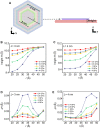Negative or Positive? Loading Area Dependent Correlation Between Friction and Normal Load in Structural Superlubricity
- PMID: 35178378
- PMCID: PMC8844525
- DOI: 10.3389/fchem.2021.807630
Negative or Positive? Loading Area Dependent Correlation Between Friction and Normal Load in Structural Superlubricity
Abstract
Structural superlubricity (SSL), a state of ultra-low friction between two solid contacts, is a fascinating phenomenon in modern tribology. With extensive molecular dynamics simulations, for systems showing SSL, here we discover two different dependences between friction and normal load by varying the size of the loading area. The essence behind the observations stems from the coupling between the normal load and the edge effect of SSL systems. Keeping normal load constant, we find that by reducing the loading area, the friction can be reduced by more than 65% compared to the large loading area cases. Based on the discoveries, a theoretical model is proposed to describe the correlation between the size of the loading area and friction. Our results reveal the importance of loading conditions in the friction of systems showing SSL, and provide an effective way to reduce and control friction.
Keywords: friction; graphene; molecular dynamics simulation; normal load; structural superlubricity.
Copyright © 2022 Wang, Wang and Ma.
Conflict of interest statement
The authors declare that the research was conducted in the absence of any commercial or financial relationships that could be construed as a potential conflict of interest.
Figures




References
-
- Girifalco L. A., Hodak M., Lee R. S. (2000). Carbon Nanotubes, Buckyballs, Ropes, and a Universal Graphitic Potential. Phys. Rev. B 62 (19), 13104–13110. 10.1103/physrevb.62.13104 - DOI
LinkOut - more resources
Full Text Sources

